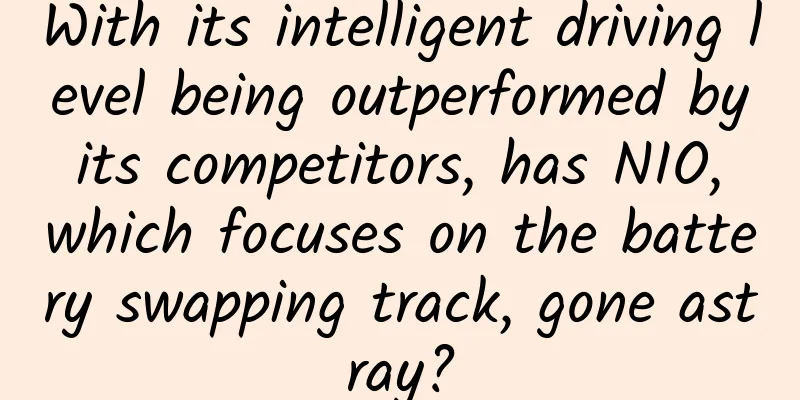With its intelligent driving level being outperformed by its competitors, has NIO, which focuses on the battery swapping track, gone astray?

|
For today’s car companies, if they can’t get high scores in the intelligent driving segment, they will basically lose the opportunity to face the future. Many people may not have thought that NIO will one day lose its “voice” in this regard. As a leader among new forces, NIO can be regarded as the "big brother" in the "Wei, Xiao, and Li Auto" era. Times have changed. NIO, which was popular in the car industry with its innovation, has now become the target of users' complaints. Some NIO owners have also begun to express disappointment with its smart driving. Not long ago, a user of Bilibili named "Jingqi Super Intelligence" criticized Weilai's intelligent driving, saying that it has "poor path-finding ability. Two months ago, Zhiji used one OrinX to rub Weilai, which has four OrinX, hard on the ground. Unexpectedly, two months later, Zhiji's mass-produced version can be driven all over the country, and the gap has been reduced to 40:7. It's really outrageous. Where did the ambition of the world's first 1000T computing power go? It makes me think... Wang Kang, project director of Zhiji Intelligent Driving, also publicly criticized NIO Intelligent Driving on Weibo by quoting a netizen’s words. The netizen said: I have both cars. Let me put it this way. Zhiji I use NOA when I go out. When will NIO refund my money? I really don’t use it anymore. I have nothing to say. Wang Kang not only commented on the Weibo post, but also made a fist gesture. Regardless of whether this statement is somewhat "biased" towards Zhiji, NIO's intelligent driving technology does have a mediocre reputation in the market. As early as 2021, the media had counted it. As of 2021, NIO has had 4 negative news due to autonomous driving. One of the more serious incidents was that the owner of a NIO ES8 lost his life directly due to an abnormal autonomous driving function. According to media reports, the "autonomous driving function" (NOP pilot state) was enabled when the accident occurred. The maximum speed of the vehicle exceeded 110 kilometers per hour, and there was no sudden deceleration before the accident. If the various accidents in those years were due to the fact that NIO’s smart driving technology was not mature enough, then the accident that just happened this year may be able to better demonstrate NIO’s smart driving level. According to news reports, at around 0:42 a.m. on November 12, Mr. Liu, who works in car sales, was driving a "NIO EC6" SUV from Yibin, Sichuan to Chengdu. He had just driven about two kilometers on the highway when he suddenly crashed head-on into an "obstacle" in front of him, causing damage to the vehicle and injuries. He said that after entering the highway, he turned on the smart driving and drove within the specified speed. At the time of the accident, "neither the EBS nor the laser guidance system worked." All the complaints from car owners and accidents make people wonder whether NIO has really invested heavily in intelligent driving, and whether its current development has deviated from the "main theme" of the smart electric era. Judging from the actual investment, NIO still attaches great importance to technology. At the "Automotive Globalization and Sustainable Development" sub-forum a few days ago, NIO CFO Qu Yu said that NIO has invested more than 50 billion yuan in research and development in the ten years since its establishment. Starting from 2022, NIO will basically maintain an annual R&D investment intensity of 10 billion yuan, and basically maintain it at around 3 billion yuan each quarter. The NIO team currently has about 11,000 engineers, and the total number of patents applied for and authorized worldwide has reached 9,300. Although this R&D investment cannot be regarded as the highest in the automotive industry, it is definitely a "big deal." So, with such a huge investment, why is Weilai's intelligent driving still unsatisfactory? Here we may also need to consider another factor, that is, the battery swap stations that Weilai has been building. In recent years, NIO has invested most of its energy in battery swapping, and naturally a large part of its R&D funds must be allocated to battery swapping. Referring to the construction costs of the first, second, and third generation battery swapping stations, the construction cost of the first generation battery swapping station is about 3 million yuan, the second generation battery swapping station costs about 2 million yuan, and the third generation battery swapping station costs about 1.5 million yuan. Although this cost will be reduced with the advancement of technology, the battery swapping station network that NIO wants to build is too large. Now there are about 2,429 battery swapping stations across the country. It is conceivable how much investment is involved in technology and other aspects. But if you gain one thing, you will easily lose the other. In recent years, when talking about NIO, the impression of "loss" is always brought along. The financial report shows that NIO's "other sales" revenue in 2023 was 6.36 billion yuan, the cost was 7.9786 billion yuan, and the annual loss reached 1.8 billion yuan. In the first quarter of this year, NIO achieved operating income of 9.909 billion yuan, a year-on-year decline of 7.2%. Even though NIO's adjusted operating loss in the first quarter was 5.112 billion yuan, a reduction of about 15.6% from the fourth quarter of last year, the current loss situation has not been reversed. Now, the battery swap station network built by NIO covering the whole country has not yet reached a break-even point. The financial "black hole" for so many years means that it may be really difficult for NIO to come up with too much money for research and development of intelligent driving technology. Of course, in addition to technical investment, NIO's average level of intelligent driving may also have some strategic reasons. As a car company that was relatively early to touch the new energy trend, NIO's sensitivity to the industry is unquestionable, so it must know the important position of intelligent driving in this era. Perhaps out of long-term considerations, NIO has chosen to develop its own products in many aspects. Currently, NIO has built 12 full-stack technology layouts, and has self-developed technologies in all sectors of smart electric vehicles. The practical problem caused by this is that the company has not been able to produce any major results for a long time. For example, it took NIO two years to develop the NPU. This strategy of insisting on self-development is destined to prevent NIO from achieving results quickly in smart driving. This also explains why NIO always feels a step behind in smart driving. From this perspective, we cannot say that NIO has "deviated". At most, it has prioritized its development, such as giving priority to battery swapping and slowly developing smart driving technology. Fortunately, with the maturity of battery swapping technology and the reduction of investment costs, NIO now has more energy to deepen its smart driving technology. In mid-2023, NIO officially announced that its first self-developed chip, the laser radar main control chip "Yang Jian", was officially put into mass production. NIO officially stated that the "Yang Jian" chip is the first chip developed by its smart hardware team. It uses an 8-core 64-bit processor with powerful computing power. The chip is also equipped with an 8-channel 9-bit ADC with a sampling rate of up to 1GHz, which can efficiently capture the raw data of the laser radar sensor while reducing power consumption to 50%. In July this year, NIO announced that its self-developed world's first 5nm automotive-grade intelligent driving chip, the Shenji NX9031, had been successfully taped out. According to NIO's official introduction, its chip's self-developed image, signal processor, and ISP have a processing delay of less than 5 milliseconds, which is 75% shorter than the industry average. Regardless of how much NIO has invested in intelligent driving, it has achieved good results so far. As the No. 1 new force, NIO's industry sense is unquestionable. However, if it wants to run faster on the current track, it may still need to devote more energy to intelligent driving. After all, in this era of sailing against the current, if you don't move forward, you will fall behind. If you slow down by one step, you will slow down by a hundred steps. Facing a galloping opponent, if you want to catch up when you are behind, you will never catch up. As a winner of Toutiao's Qingyun Plan and Baijiahao's Bai+ Plan, the 2019 Baidu Digital Author of the Year, the Baijiahao's Most Popular Author in the Technology Field, the 2019 Sogou Technology and Culture Author, and the 2021 Baijiahao Quarterly Influential Creator, he has won many awards, including the 2013 Sohu Best Industry Media Person, the 2015 China New Media Entrepreneurship Competition Beijing Third Place, the 2015 Guangmang Experience Award, the 2015 China New Media Entrepreneurship Competition Finals Third Place, and the 2018 Baidu Dynamic Annual Powerful Celebrity. |
<<: Detailed explanation of Win10's new game mode: How much can it improve gaming?
>>: Why is Samsung the only one still using stylus when there were so many of them on the street?
Recommend
Is bacon "real meat"? Is it harmful to the body?
Enoki mushroom bacon rolls, bacon rolled mashed p...
How much does it cost to be an agent of Jiaxing Building Materials Mini Program? What is the price of Jiaxing building materials mini program agent?
How much does it cost to be an agent for a buildi...
Sony 55-inch 4K TV review: Beautiful interface and excellent workmanship
Nowadays, televisions are becoming more and more ...
A complete method for event operation!
Let me talk about my views on event operations . ...
Crisis PR Guide for the Catering Industry
Whether you watched this year’s 315 Gala or not, ...
Floods in Wanzhou, Chongqing have caused 15 deaths and 4 missing! Please take precautions!
According to the Emergency Management Bureau of W...
The infected person dies within 90 days? Is the "super fungus" really coming?
Rumors Recently, the news that "Candida auri...
There is a "sausage" in the universe? It's hundreds of light years long!
Your browser does not support the video tag Autho...
Why is the meter still running when the appliances are not in use? Who is "stealing" your appliances?
Shut down the machine without interrupting power ...
Event planning and promotion, how to plan and execute an event?
1. Event Planning Overview There are three keys t...
Tik Tok live broadcast planning case analysis!
This is an era where genius planning prevails. Wh...
Will 2023 be the hottest summer in the past 2,000 years? | Environmental News
Hottest summer in the past 2,000 years Last year&...
There are new clues about the ninth planet, and it is expected to be discovered in about ten years?
An artist's impression of the ninth planet Pl...






![Zhu Dan's Basic Sketching Course [General Quality]](/upload/images/67cc28b7b8171.webp)


